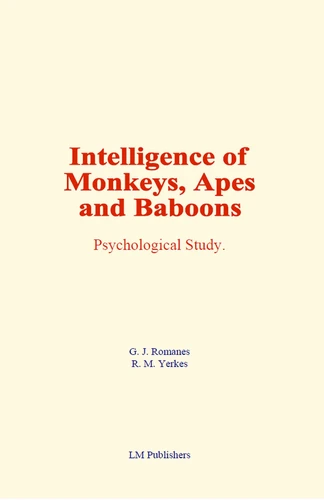Intelligence of Monkeys, Apes and Baboons. Psychological Study
Par : ,Formats :
Disponible dans votre compte client Decitre ou Furet du Nord dès validation de votre commande. Le format Multi-format est :
- Pour les liseuses autres que Vivlio, vous devez utiliser le logiciel Adobe Digital Edition. Non compatible avec la lecture sur les liseuses Kindle, Remarkable et Sony
 , qui est-ce ?
, qui est-ce ?Notre partenaire de plateforme de lecture numérique où vous retrouverez l'ensemble de vos ebooks gratuitement
Pour en savoir plus sur nos ebooks, consultez notre aide en ligne ici
- FormatMulti-format
- ISBN978-2-38111-392-0
- EAN9782381113920
- Date de parution10/05/2022
- Protection num.NC
- Infos supplémentairesMulti-format incluant ePub avec ...
- ÉditeurLM Publishers
Résumé
Although monkeys do not reach the human stage of a rich life of ideas, yet they carry the animal method of learning by the selection of impulses and association of them with different sense impressions, to a point beyond that reached by any other of the lower animals. In this, too, they resemble man; for he differs from the lower animals not only in the possession of a new sort of intelligence but also in the tremendous extension of that sort which he has in common with them...
The intelligence of apes, monkeys, and baboons, unfortunately, has not presented material for nearly so many observations as that of other intelligent mammals.
Useless for all purposes of labour or art, mischievous as domestic pets, and in all cases troublesome to keep, these animals have never enjoyed the improving influences of hereditary domestication, while for the same reasons observation of the intelligence of captured individuals has been comparatively scant. Still more unfortunately, these remarks apply most of all to the most man-like of the group, and the nearest existing prototypes of the human race: our knowledge of the psychology of the anthropoid apes is less than our knowledge of the psychology of any other animal.
But notwithstanding the scarcity of the material which I have to present, I think there is enough to show that the mental life of the Simiadæ is of a distinctly different type from any that we have hitherto considered, and that in their psychology, as in their anatomy, these animals approach most nearly to Homo sapiens...
Useless for all purposes of labour or art, mischievous as domestic pets, and in all cases troublesome to keep, these animals have never enjoyed the improving influences of hereditary domestication, while for the same reasons observation of the intelligence of captured individuals has been comparatively scant. Still more unfortunately, these remarks apply most of all to the most man-like of the group, and the nearest existing prototypes of the human race: our knowledge of the psychology of the anthropoid apes is less than our knowledge of the psychology of any other animal.
But notwithstanding the scarcity of the material which I have to present, I think there is enough to show that the mental life of the Simiadæ is of a distinctly different type from any that we have hitherto considered, and that in their psychology, as in their anatomy, these animals approach most nearly to Homo sapiens...
Although monkeys do not reach the human stage of a rich life of ideas, yet they carry the animal method of learning by the selection of impulses and association of them with different sense impressions, to a point beyond that reached by any other of the lower animals. In this, too, they resemble man; for he differs from the lower animals not only in the possession of a new sort of intelligence but also in the tremendous extension of that sort which he has in common with them...
The intelligence of apes, monkeys, and baboons, unfortunately, has not presented material for nearly so many observations as that of other intelligent mammals.
Useless for all purposes of labour or art, mischievous as domestic pets, and in all cases troublesome to keep, these animals have never enjoyed the improving influences of hereditary domestication, while for the same reasons observation of the intelligence of captured individuals has been comparatively scant. Still more unfortunately, these remarks apply most of all to the most man-like of the group, and the nearest existing prototypes of the human race: our knowledge of the psychology of the anthropoid apes is less than our knowledge of the psychology of any other animal.
But notwithstanding the scarcity of the material which I have to present, I think there is enough to show that the mental life of the Simiadæ is of a distinctly different type from any that we have hitherto considered, and that in their psychology, as in their anatomy, these animals approach most nearly to Homo sapiens...
Useless for all purposes of labour or art, mischievous as domestic pets, and in all cases troublesome to keep, these animals have never enjoyed the improving influences of hereditary domestication, while for the same reasons observation of the intelligence of captured individuals has been comparatively scant. Still more unfortunately, these remarks apply most of all to the most man-like of the group, and the nearest existing prototypes of the human race: our knowledge of the psychology of the anthropoid apes is less than our knowledge of the psychology of any other animal.
But notwithstanding the scarcity of the material which I have to present, I think there is enough to show that the mental life of the Simiadæ is of a distinctly different type from any that we have hitherto considered, and that in their psychology, as in their anatomy, these animals approach most nearly to Homo sapiens...



